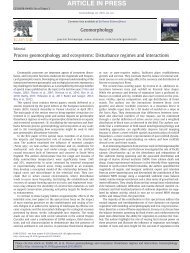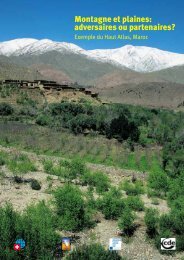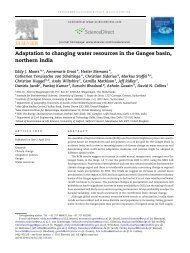(2010): Debris-flow activity along a torrent in - Dendrolab.ch
(2010): Debris-flow activity along a torrent in - Dendrolab.ch
(2010): Debris-flow activity along a torrent in - Dendrolab.ch
Create successful ePaper yourself
Turn your PDF publications into a flip-book with our unique Google optimized e-Paper software.
Author's personal copy<br />
A. Sorg et al. / Dendro<strong>ch</strong>ronologia 28 (<strong>2010</strong>) 215–223 221<br />
Fig. 5. Germ<strong>in</strong>ation dates of the sampled trees suggest that a devastat<strong>in</strong>g<br />
debris-<strong>flow</strong> event <strong>in</strong> the 1880s had cleared the surface and<br />
scoured the currently active <strong>ch</strong>annel. This <strong>in</strong>terpretation is supported<br />
by topographical maps from 1881 to 1891, whi<strong>ch</strong> show a dislocation<br />
of the <strong>ch</strong>annel (Swisstopo, 2006).<br />
time elapsed between tree germ<strong>in</strong>ation and the time needed<br />
for the trees to rea<strong>ch</strong> sampl<strong>in</strong>g height, we added a locally<br />
observed average tree age at sampl<strong>in</strong>g height, thus respect<strong>in</strong>g<br />
accelerated juvenile growth.<br />
The time elaps<strong>in</strong>g between the deposition of material by a<br />
debris <strong>flow</strong> and the actual colonization of the bare surfaces by<br />
tree seedl<strong>in</strong>gs varies between a s<strong>in</strong>gle year and several years<br />
up to decades (Yoshida et al., 1997; Ko<strong>ch</strong>, 2009). This uncerta<strong>in</strong>ty<br />
cannot be reduced further, as it is an <strong>in</strong>herent element<br />
of the methodology. At our study site, there is clear observational<br />
evidence that recently cleared surfaces are recolonized<br />
by pioneer species su<strong>ch</strong> as L. decidua and Betula pendula<br />
Roth. with<strong>in</strong> only a few years after geomorphic events (personal<br />
observations and L. Jörger, verbatim). This rather short<br />
germ<strong>in</strong>ation lag time (ecesis) is most likely due to favourable<br />
climatic and soil conditions su<strong>ch</strong> as low elevation and substantial<br />
<strong>in</strong>put of f<strong>in</strong>e-textured material, but it is also the result<br />
of abundant seed sources <strong>in</strong> nearby forests.<br />
Based on the germ<strong>in</strong>ation dates of the oldest trees sampled<br />
<strong>along</strong> the <strong>ch</strong>annel, we suggest that a devastat<strong>in</strong>g debris <strong>flow</strong><br />
must have occurred <strong>in</strong> the early 1880s, elim<strong>in</strong>at<strong>in</strong>g the former<br />
stand <strong>in</strong> the area of the current <strong>ch</strong>annel. This <strong>in</strong>terpretation<br />
is supported by two topographical maps dat<strong>in</strong>g back to 1881<br />
and 1891 (Fig. 5, Swisstopo, 2006), where a dislocation of<br />
the debris-<strong>flow</strong> <strong>ch</strong>annel on the cone is evident, <strong>ch</strong>ang<strong>in</strong>g its<br />
course from an east–west to the current southeast–northwest<br />
direction. Su<strong>ch</strong> drastic <strong>ch</strong>anges <strong>in</strong> the <strong>flow</strong> direction are often<br />
associated with major debris-<strong>flow</strong> <strong>activity</strong>, whi<strong>ch</strong> apparently<br />
occurred <strong>in</strong> the Geisstriftba<strong>ch</strong> <strong>torrent</strong> sometimes between<br />
1881 and 1891.<br />
In addition, debris <strong>flow</strong>s strongly determ<strong>in</strong>e <strong>in</strong>dividual<br />
tree growth and stand dynamics. For trees <strong>along</strong> the Geisstriftba<strong>ch</strong><br />
<strong>torrent</strong>, we propose that succession is hampered<br />
repeatedly by debris <strong>flow</strong>s <strong>in</strong> the upper part of the <strong>ch</strong>annel,<br />
and that trees are fairly easily removed by <strong>in</strong>cidents. In contrast,<br />
debris-<strong>flow</strong> <strong>activity</strong> appears to have a less devastat<strong>in</strong>g<br />
and disturb<strong>in</strong>g effect on trees with <strong>in</strong>creas<strong>in</strong>g distance from<br />
the cone apex, where slope gradients are considerably smaller<br />
and the impacts of <strong>in</strong>dividual debris-<strong>flow</strong> surges less severe.<br />
Besides the fact that trees are mu<strong>ch</strong> younger <strong>in</strong> the upper part<br />
with germ<strong>in</strong>ation dates between 1930 and 1970, they have<br />
also been disturbed more frequently. Close to the cone apex,<br />
only a few L. decidua were able to colonize and broadleaved<br />
pioneer trees su<strong>ch</strong> as Sorbus aucuparuia L. and B. pendula<br />
are dom<strong>in</strong>ant today. Thus, the assessment of tree germ<strong>in</strong>ation<br />
dates provides – with all limitations <strong>in</strong>volved due to the<br />
rather limited sample size – an <strong>in</strong>dependent l<strong>in</strong>e of evidence<br />
support<strong>in</strong>g a causal basis for the correlation of higher tree<br />
age with <strong>in</strong>creas<strong>in</strong>g distance from the source of debris-<strong>flow</strong><br />
<strong>activity</strong> (Bolls<strong>ch</strong>weiler et al., 2008b).<br />
The age structure of trees sampled <strong>along</strong> the Geisstriftba<strong>ch</strong><br />
<strong>torrent</strong> also <strong>in</strong>dicates that trees are <strong>in</strong>itially grow<strong>in</strong>g up<br />
<strong>in</strong> cohorts, but that only s<strong>in</strong>gle trees manage to outgrow competitors.<br />
This growth pattern is one of the reasons for the<br />
clumped distribution of even-aged trees <strong>along</strong> the <strong>ch</strong>annel.<br />
Typical succession <strong>in</strong> the sub-alp<strong>in</strong>e area with predom<strong>in</strong>ance<br />
of conifers usually beg<strong>in</strong>s with fast-establish<strong>in</strong>g L. decidua<br />
on raw soil (Frehner et al., 2005). Protected from glid<strong>in</strong>g and<br />
slid<strong>in</strong>g snow, P. abies then beg<strong>in</strong>s to regenerate and gradually<br />
replaces L. decidua if growth conditions are stable (Frehner<br />
et al., 2005). However, this <strong>ch</strong>ange of tree species only partially<br />
occurs <strong>along</strong> Geisstriftba<strong>ch</strong> <strong>torrent</strong> as succession is<br />
repeatedly thrown back to the <strong>in</strong>itial stages after devastat<strong>in</strong>g<br />
debris-<strong>flow</strong> events. Under su<strong>ch</strong> unsteady growth conditions,<br />
L. decidua should be promoted actively, as it is a tree species<br />
highly adapted to external disturbances (Frehner et al., 2005).<br />
The analysis of the growth disturbances of 26 heavily<br />
affected L. decidua and 2 P. abies allowed for an identification<br />
of 13 debris <strong>flow</strong>s <strong>along</strong> the Geisstriftba<strong>ch</strong> <strong>torrent</strong> for<br />
the period AD 1913–2006. But we need to bear <strong>in</strong> m<strong>in</strong>d that<br />
the debris-<strong>flow</strong> frequency provided <strong>in</strong> this study only represents<br />
the m<strong>in</strong>imum number of events that have occurred <strong>in</strong><br />
the Geisstriftba<strong>ch</strong> <strong>torrent</strong> <strong>in</strong> the period <strong>in</strong>vestigated, because<br />
(i) the number of trees selected is rather small, (ii) because<br />
we exclusively sampled trees <strong>along</strong> the <strong>torrent</strong> and thus<br />
may have overlooked part of the events and as (iii) <strong>in</strong>dividual<br />
events may have been conta<strong>in</strong>ed with<strong>in</strong> the <strong>ch</strong>annel,<br />
i.e. without disturb<strong>in</strong>g any trees <strong>in</strong> the levees and on the<br />
cone. Similarly, the time elapsed between <strong>in</strong>dividual events is<br />
quite regular and does not provide any clear evidence for an<br />
<strong>in</strong>crease or decrease <strong>in</strong> debris-<strong>flow</strong> frequency, although su<strong>ch</strong><br />
<strong>ch</strong>anges have been put forward as an early <strong>in</strong>dicator of global<br />
<strong>ch</strong>ange (Jomelli et al., 2004; Stoffel and Beniston, 2006;<br />
Bolls<strong>ch</strong>weiler and Stoffel, <strong>in</strong> press). Due to the restricted<br />
sample depth, implications for forest dynamics are limited.<br />
Lastly, the position of repeatedly disturbed trees provides<br />
evidence regard<strong>in</strong>g preferential breakout locations of debris<br />
<strong>flow</strong>s <strong>along</strong> the <strong>torrent</strong>. For example, due to frequent disturbances<br />
reconstructed <strong>in</strong> the trees sampled at ∼1280 m a.s.l.<br />
<strong>along</strong> the southern levee, this area can be considered to be<br />
su<strong>ch</strong> a preferential breakout location. Even though disturbance<br />
<strong>in</strong>tensity is higher near the cone apex, trees <strong>in</strong> the<br />
lower part <strong>along</strong> the Geisstriftba<strong>ch</strong> <strong>torrent</strong> have also been






